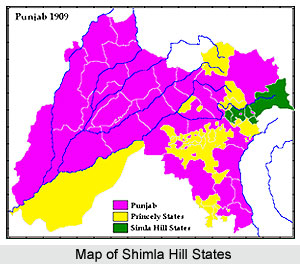 The Shimla Hill States included a number of Princely States of India that were situated in the hilly regions during the reign of the British Empire in India. During the rule of the British Government of India, 2 separate groups of princely states in the Indian regions of the British province of Punjab were included into British dominated India later than almost all of the Mughal Empire, in the context of 2 wars and a revolt. The territory of the erstwhile Shimla Hill States included twenty eight former Indian princely states, including feudatory princes and zaildars, in the promontories of the western Himalaya. The region comprised of mainly Hindu population and included some Buddhist populace as well. The local languages included Urdu, Punjabi, Hindu and other regional hilly dialects.
The Shimla Hill States included a number of Princely States of India that were situated in the hilly regions during the reign of the British Empire in India. During the rule of the British Government of India, 2 separate groups of princely states in the Indian regions of the British province of Punjab were included into British dominated India later than almost all of the Mughal Empire, in the context of 2 wars and a revolt. The territory of the erstwhile Shimla Hill States included twenty eight former Indian princely states, including feudatory princes and zaildars, in the promontories of the western Himalaya. The region comprised of mainly Hindu population and included some Buddhist populace as well. The local languages included Urdu, Punjabi, Hindu and other regional hilly dialects.
Under the rule of the British administration, Shimla, initially known as Simla, was declared the summer capital of the British Empire in India in the year 1864. The region was referred to as the Queen of Hills by the British administration. The Raja of Bashahr, a princely state situated in the hilly western Himalaya peninsula in the northern region of colonial Punjab, ruled over a territory of 3 quarters of the around 12,000 km area, on either sides of the Sutlej river. Bashahr ranked first in order of precedence among the Shimla Hill States and was perhaps the largest of the 28 Shimla Hills States. Its direct tributaries were the Thakur of Khaneti and the Thakur of Delath. Apart from these, there were other smaller princely states, including some states with few petty dependencies of their own, which were located further south on the left bank of the Sutlej river. Its direct tributaries included the Rana of Balsan, the Thakur of Beja, the Rana of Bhajji, a prince of Bhagat, His Highness Raja of Bilaspur, the Rana of Darkoti, the Rana Shri of Dhami, the Raja Rana of Jubbal, the Raja of Keonthal, the Thakur of Kunahair, the Rana of Kuthar, the Thakur of Mahlog, the Rana of Mangal, the Raja of Nalagarh, the Thakur of Sangri and the Thakur of Tharhoch (Tiroch).
The princely state of Jubbal comprised of 2 tributaries, the Thakur sahib of Dhadi and the ruler of Rawingarh. After the country gained independence from the British administration, all of the states included in the territory of the Shimla Hill States were later joined with the present state of Himachal Pradesh, India.






































